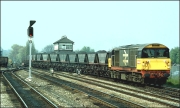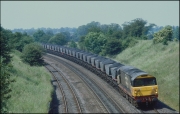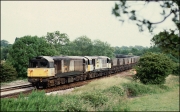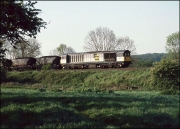 |
I had a wander around the Water Orton area on 12 February 1988, a perfectly still and sunny late winter day. I hadn't been to this spot before
but took to it immediately because it was possible to include in any photograph the buildings and chimneys of Hams Hall Power Station which were
demolished in 1993. This train, hauled by 58004 in as-built condition, was on its way to Didcot PS, one of many such workings to be seen each day at this time. 645
|
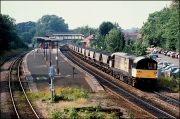 |
Class 58 was the standard power for MGRs from the East Midlands to Didcot Power Station on 1991. in this shot from a slightly murky 26 July 1991 58006 is seen passing the well patronised car park at Dorridge station on 26 July 1991. This
load of coal in HAA hoppers came from Welbeck colliery but before long most coal for Didcot was imported and ran from Avonmouth Docks at Bristol, mostly hauled by class 60. This saw a huge reduction in traffic
on the GWR Birmingham to Oxford Line.
|
 |
This picture was taken on the morning of 16 February 2001 showing 58042 with the 6G38 Chaddesden to Bescot empty spent ballast working passing Catholme near Wychnor Junction. The construction of the Central Rivers
depot is virtually finished and the trackwork is seen in the final stages of connection. The heavy early morning mist through which I had driven was retreating towards the Burton on Trent and Derby area leaving clear skies which
lasted for most of the day. 645
|
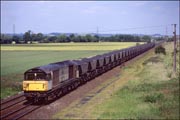 |
A couple of years before the slide of 58042 as shown above was taken at Catholme there ws no sign of the Central Rivers depot in the background as 58006 crawled past
about to be turn right right onto the Lichfield line at Wychnor Junction with an MGR going to Rugeley Power Station. I don't know from where this load of coal originated
as the origins varied on a daily basis and without the weekly coal sheets it was not possible to have mpore than a guess. 645
|
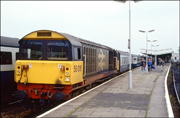 |
The line through Leamington Spa saw many diverted passenger trains on Saturday 11 May 1985. One of the most notable was the use of 58016 on a down express pictured
just after arrival and before many of the passengers alighted and charged down the platform for their pictures.
|
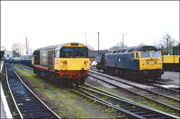 |
During the Spring of 1985 it was the practice on some mornings for a northbound freightliner to change locomotives at Leamington Spa. On 4 May of that
58016 was in the bay sidings adjacent to platform 1 along with 47129 which appeared to have been paired with a crippled MGR hopper. This picture shows
the class 58 leaving the bay ready to take over the 'liner from 31170. A black and white image I took a few minutes earlier
shows it together with a single unit DMU about to leave on a Stratford-upon-Avon service and a couple of class 116 DMUs.
|
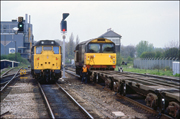 |
In this picture from 4 May 1985 George, the duty Leamington Spa shunter (never knowingly seen without a cigarette in his mouth) is coupling 58016 to its train
as 31170 leaves the station from where it wil presumably head to Bescot having been signalled onto the Coventry line.
|
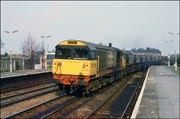 |
Another photograph of 58106 as it takes the down main line through Leamington Spa on 7 May 1985 when peforming the most commonplace duty for the class.
The train is an empty MGR from Didcot Power Station to one of the many East Midlands stabling or disposal points. I think that 58016 is the only member of its clas
to be preserved in the UK and is currently at Leicester undergoing the vast amount of work necessary to run again.
|
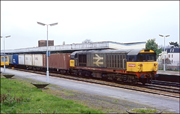 |
There wasn't much light at Leamington Spa on 4 May 1985 when 58018 took an up freightliner through Leamington Spa. I didn't record the shutter speed used
for this shot but it wasn't fast enough as can be seen by the speed blur on the front of the locomotive. The freight is passing a single unit DMU getting
ready to form one of the two-hourly services to Stratford-upon-Avon.
|
 |
A few miles north of Leamington Spa for this picture of 58022 descending Hatton Bank with a loaded MGR on its way to Didcot Power Station on 4 June 1988.
I took this particular view largely to take advantage of the hawthorn blossom and the slightly misty background with a field of sheep prominent.
There were a few other photographers around this day as GWR Castle 5051 was working on the down line
with the exhibition train which travelled around the country to mark the 150th anniversary of the incorporation of the Great Western Railway.
|
 |
Class 58 locomotives spent most of their working lives hauling MGR coal traffic between disposal points and power stations but on 4 June 1991
58009 was used for a front line inter-regional passenger train. It worked the 14.20 Paddington to Liverpool Lime Street at least as far as Birmingham New Street
and I was fortunate enough to be at Reading about to catch a local train to Basingtstoke when the class 58 and its train rolled into platform 5. This shot, one of several I reeled off, was taken
as a West of England express entered platform 4.
|
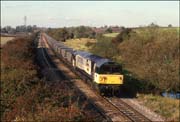 |
Back to normal for class 58 as 58038 takes and empty MGR from either Rugeley or Willington Power Station to one of the East Midlands coal loading points. This scene was so ordinary at the time
that the light had to be just right to even bother picking up a camera but I'm glad now that I did take a reasonable selection.
|
 |
Class 58s were becoming a bit thin on the ground by the beginning of 2001 so I was pleased to get this sunny shot of 58049 at Clay Mills, near Burton-on-Trent with a Hicks Lodge opencast site to Daw Mill working. The coal from Hicks Lodge was of poor quality and required blending with
the better product from the latter colliery before being fit for power station use. 60016 is just visible in the up loop with the morning Washwood Heath to Peak Forest train. 645
|
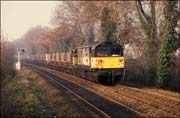 |
In early 1991 there were several trains of power station coal each day on the line to Ironbridge Station. This one showing 58009 was taken on 19 January 1991, a morning with quite thick fog early on but which was clearing as the returning empties climbed along
the wooded enbankment of Albrighton Bank and was just about to pass through the station of the same name. A pleasant enough if slightly bland location.
|
 |
One of the most popular spots for photographers on the line from Wolverhampton to Ironbridge Power Station was Cosford. Easy access, semaphore signals and a decent view in each direction made the bridge just beyond the station a regular location for many.
On 19 January 1991 I was there in the late morning when 58005 was working an empty MGR from the power station to either Silverdale or Littleton colliery. A few years later the same locomotive broke new ground for the class when it visited Stratford-upon-Avon
with a Pathfinder railtour, pictured here leaving the Stratford branch at Hatton Station Junction.
|
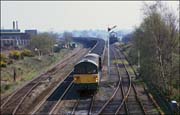 |
The train shown above behind 58005 had only just cleared the bridge at Cosford on 19 January 1991 when 58009 came the other way with yet another load of coal for Ironbridge Power Station.
This had come from Silverdale - the flat tops of the coal in the HAAs gave this away. Both up and down loops were regularly used at the time but despite visiting the area on many occasions
never had a shot of a train in either.
|
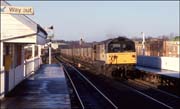 |
Cosford station was a good spot for eastbound trains in the late morning - as long as you told the chap in the ticket office why you were there(!) - as the wooden platforms
and buildings, not to mention the signals, were an attractive feature. It was a pain that it wan't possible to include both signal arms on the platform-end gantry and the buildings in this view
from 19 January 1991 as 58010 worked towards Wolverhampton with a set of empty HAAs. Class 58s were the staple power at this time but it was still possible to see pairs of class 20s
from time to time as this shot from a couple of weeks earlier (and showing the whole gantry, signal box and aircraft at RAF Cosford) demonstrates.
|
_CastD_051094) |
The vast majority of class 58's work was hauling heavy MGR coal trains around the network, especially the East Midlands area. This image shows 58002 shortly after passing the
mothballed power station at Castle Donnington with an empty train heading towards one of the loading points in the Nottinghamshire coalfields. In 2020 the power station and its
associated infrastructure has gone to be replaced with sidings currently used for the storage of a few types of rolling stock and for some intermodal traffic.
|
_Sten_051094) |
Rugeley Power Station consumed enormous tonnages of coal most of which came from the East Midlands collieries and was transported by MGR trains usually hauled
by class 58s. An empty train from Rugeley is shown here passing the power station at Willington just to the south of Stenson Junction where the line to Toton via Castle Donnington
diverges.
|
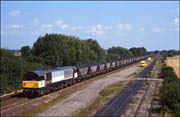 |
Looking from the other side of the bridge at Stenson Junction this picture shows 58035 with a loaded train going to Rugeley Power station. It was never easy without the weekly coal sheets
to identify the origin of these trains and all I know is that is came from the Derby line rather than the Toton via Castle Donnington direction.
|
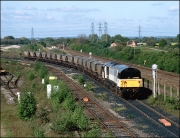 |
The most interesting shots at Willington were, for me at least, those showing MGR trains going into and out the power station. Here is 58031 with what appears to be a mini-size MGR leaving the complex but
in reality there had a been a problem with one of the HAAs which had had to be shunted out of the train and dumped in the cripple siding for collection (or not!) at some future point. The process didn't
take too long and the two parts of the consist were soon joined together and left the power station ready to be reloaded with another batch of coal.
|
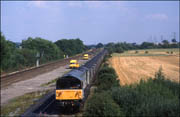 |
I was at Willington a few weeks before the shot above was taken and took this image of 58045 heading to the MGR loop at the power station. Once again I have no idea where this train had come from but it
had run via Castle Donnington on the dedicated tracks laid for this purpose which avoids the junction with the main Derby line at Stenson Junction.
|
 |
I spent a few hours in the Barrow Hill area on 22 August 1990 and among several steel and departmental trains obtained this shot of 58021 at Hall Lane Junction. I went without any "gen" and unfortunately have no real idea of the origin or destination
of this train but it is likely that it came either from Oxcroft or Markham colliery and is heading to Barrow Hill sidings for staging. The line curving away to the left is that going to or from Tinsley and Rotherham Central but in 2020, following the loss of all MGR coal traffic, all these lines have been lifted
and just the bare trackbed remains.
|
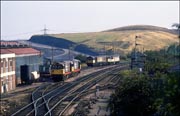 |
This is a general view of Shirebrook stabling point taken on 22 August 90 with 58046, 58006, 58016 and 56016 parked up until their next jobs. The latter 2 locomotives had only just arrived and here is my shot of them
as they passed passed the signal box at Shirebrook Junction. The facility at Shirebrook was opened in 1966 and finally closed in 2005 after being downgraded
from a diesel maintentance depot to a stabling and fuelling point. It was situated to the site the site of the closed Shirebrook West station which was then a freight-only line but in 2020 is part of the Robin Hood passenger line.
|
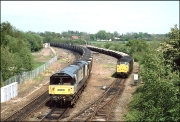 |
Class 58's staple diet in the early 1990s was hauling MGR traffic from collieries or coal disposal points to power stations. Here, 58039 is pictured coming off the Kingsbury loop at Whitacre Junction with a load of coal destined for Ironbridge
on 13 May 1992. 31438 is sitting in the loop waiting for a path to Bescot with a load of ballast from Croft quarry in Leicestershire. The scene here was nicely open in 1992 but in recent times has become overgrown, as have many other locations,
to the point where photography is barely worth the effort.
|
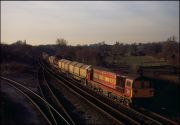 |
I had spent the lovely afternoon of 15 February 2001 at Hatton North Junction and photographing a selection of freights behind classes 37, 47 and 60. While walking back along the canal towpath to the station car park a friend who had been photographing further north
telephoned to tell me that 58049 was heading south with the Wolverhampton to Hoo Junction empty wagons. I hurried up a bit and arrived on the roadbridge just in time to get this image, just catching the last rays of the sun. I had previously photographed this train on several occasions
with both single and double-headed class 37s but as far as I can remember this was the only time that I saw a 58 leading it.645
|
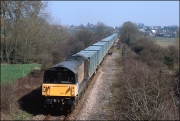 |
Class 58s were diagrammed for the Avon binliner from Calvert to Bath and Bristol in 1996. 58041 is pictured here at Water Eaton Farm near Islip with the returning empty containers on 4 April 1996. This was a bridge on a private road to the farm
and on my first trip there, without knowing this important fact, I arrived in the farmyard to be met by the landowner asking what was I doing. I told him amd asked permission to walk to his bridge. He said that he was sorry, but no as
they had had some problems with security issues. As he was saying this he noticed my parking pass for my then office on the windscreen of my car. He pointed it out and asked if I knew so-and-so and a few others. Yes, I did and was welcomed like
a long-lost brother, told I was welcome any time after a phone call and told to report to the farm house later for coffee and a cake!
|
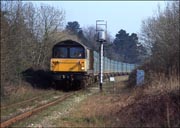 |
The train shown above was running very early so after coffee and cake at Water Eaton Farm I still had time to drive to Bicester London Road. The Calvert to Bath empty binliner had to wait there for a path over the single track to Oxford North Junction
and invariably followed one of the few passenger trains to run over the line. This shot was taken from the level crossing (or nearly from the crossing if the truth be told as a tree was growing in just the wrong place) as 58041 waited for permission
for the driver to leave the cab and operate the plunger in the box to the right of the signal post which started up the warning lights and lowered the barriers over the road. The scene here today is very different as this is now a busy double track main line
linking the GWR Oxford line with the Chiltern mainline with frequent fast services to London Marylebone. Mmm, not quite the same.....
|
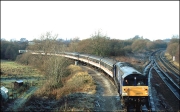 |
The cold and frosty day 14 December 1996 produced the rare sight of type 5 power on the Stratford-upon-Avon branch when Pathfinder's "The Rooster Booster" traversed the line. The train, 1Z56,
had started at Bristol Temple Meads and ran to Stratford via Worcester and then went on to Guildford, Kengsington Olympia, Northampton, Birmingham New Street and back to Bristol. Class 58, 58005 was used
to haul the train from Stratford to Guildford and is seen here at Hatton Station Junction about to join the GWR's Birmingham to Leamington Spa line. 56032 had hauled the train to Stratford from Bristol and to see a picture
of this leg of the tour at Claverdon , please use this link. 56032 at Claverdon.
|
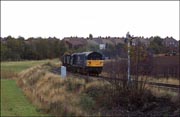 |
On 10 October 1996 I spent an hour or so inside the bounds at Drakelow Power Station by the simple expedient of climbing through a dodgy fence and standing on a pile of rubble within the triangle of lines. There were plenty
of rail personnel about and nobody appeared to take any notice of me so I took this as tacit permission to be there! The first shot is of 58021 approaching the station with a load of coal for the furnaces; from where it came I have no real idea
but suspect that it was from Nadins opencast site just a short distance away.
|
 |
This is the view inside the triangle of lines at Drakelow Power Station looking the towers and chimneys on a very dull 10 October 1996. This location wasn't much good if the sun was out as it shone in completely the wrong direction and would have been into the lens. The picture shows
58021 arriving, probably from Nadins opencast site, and 58031 departing for Toton. By this time, the signalbox was treated as a ground frame and operated by the train crews.
|
 |
My third and final shot from Drakelow Power Station on 10 October 1996 shows a closer view of 58031 leaving the station on its way back to Toton. This was the only time that I went here
and the shots are unrepeatable because on 31 March 2003 the station was decommissioned.
|
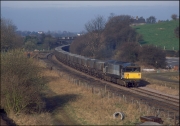 |
The Coalville line which runs from Burton-on Trent to Leicester was visited on a daily basis by class 58s on MGR duties. 58003 is seen here near Castle Gresley with the first empty train of HAAs of the day, 21 March 1995, heading for Coalfield Farm loading point.
This location is near the site of the long-closed Castle Gresley station, and just out of the picture to the right are the cooling towers of Drakelow Power Station. 645
|
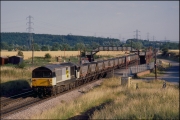 |
It looked as if 58012 had recently visited the paint shop at Toton when I photographed it at Radley, near Oxford, on 4 July 1989. This, formerly the junction for the Abingdon branch, was a great place a few hours at the time, with class 47s and 50s on passenger traffic and almost
anything at all on the regular freight trains. There were also DMMUs of several classes on local passenger turns to Banbury and Worcester. I suppose that given this station's location between Didcot and Oxford that a large number of high tension electricity pylons are in the area but they
hardly add anything attractive to the scene.645
|
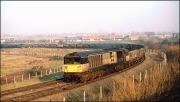 |
Ironbridge Power Station lying in the Severn Valley on the former Buildwas branch is a major consumer of coal. To facilitate easy movement of coal to the station from collieries such as Littleton and Silverdale on the WCML, the Oxley
Chord was constructed. This obviated the need for a time-consuming reversal at Bushbury Junction. On my only visit to the location in January 1991, 58012 is seen with a load of coal squealing around the tight radius curve to join the Wolverhampton
to Shrewsbury line at Oxley. The main electrified line to Wolverhampton can be seen in the background.
|
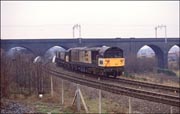 |
This is the view looking the other way from the shot above in January 1991 and shows 58002 passing under Oxley viaduct with an empty MGR from Ironbridge Power Station going back to one of the Stafforshire collieries. I recall taking a shot of a pair of class 20s here on the same day
but this was a black and white image and I can't be bothered to hunt through my folders and find it, for the time being at least.
|
 |
Staying with Ironbridge Power Station MGRs here is 58004 passing Beamish Farm, near Albrighton on the Wolverhampton to Shrewsbury line. This was a pleasant location which I visited a few times in that era but I expect that it is now completely overgrown
in common with virtually every other spot from thise days.
|
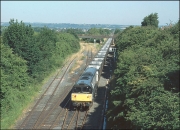 |
This shot is of 58001 passing the triangular junctions at Drakelow on the Coalville freight line. The train was photographed on 18 July 1996 as it was heading for the Nadins opencast disposal site situated a short distance to the north. The overgrown nature of the tracks leading
to Drakelow Power Station is clearly seen although the left hand line was still in regular use at this time. The train appears to be slightly unsharp in the view but I think think that the historical aspect outweighs the technical shortcomings. I never had the good fortune to photograph from this bridge a train leaving the power station in the Coalville direction as they all seemed to run from Nadins, unload and
head back to Toton on the occasions I visited the area.
|
 |
After photographing 58001 at Drakelow, it seemed sensible to drive up to the Nadins Disposal Point and have another go at it. The coal from the opencast site arrived at this point on the covered conveyor system running alongside the line and up to the loading hopper. One really needed a 300mm lens for this shot from the main road, but 200mm was the longest I had at the time. Still, I think the shot is acceptable as it shows the 58 about to
run-round the train before going to Drakelow - surely one of the shortest MGR runs in the country at the time, 18 July 1996. At one time, the line now simply a headshun, continued under the road bridge upon which I was standing and went to Cadley Colliery.
|
_230502) |
Towards the end of it's working life 58047 did some of Didcot's trip workings and on one occasion 23 May 2002, I was given a tip-off in plenty of time to drive over to Ashchurch to photograph it on the daily(ish) MOD service. The first shot shows it running north towards
Worcester where the locomotive runs round in the yard before coming back south; there being no facility to enter the exchange sidings from the Gloucester side. The sun was just coming out of some early morning cloud but didn't make it quite in time for this shot.
|
_230502) |
This isn't my usual sort of shot and I can't remember why I decided on a platform-side picture as 58047 came out of Ashchurch loop and ran towards the exchange sidings. Prominent in the shot is the old water tower which was for many years a bit of a landmark here but demolished
not longer after the date of this picture.
|
_230502) |
The usual practice at Ashchurch was for the locomotive, on the south end of the train, to propel its train along the short branch to the MOD complex with the safeguard of a man walking in front of it to make sure that
the two public footpath crossings were clear. The whistle board seems slightly superfluous as the driver is in the front cab of 58047 and wouldn't have seen it! The shunter, on foot at this point, had a 2-way radio
with which to keep the driver informed of exactly when to slow and stop.
|
 |
It was a matter of luck as to whether there was a load for the locomotive to take to Swindon from Ashchurch MOD. On 23 May 2002 there was a rake of assorted flats to come out
and here is 58047 heading slowly along the branch back to the exchange sidings on the other side of the nearby road bridge.
|
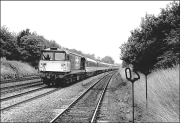 |
This picture shows 58025 on a highly unusual working for the class. The train is the summer-dated Manchester to Paignton Pullman passing Longbridge on 26 July 1986. This train was booked for a pair of ETH-fitted
31s and this although the weather wasn't good shot would be worth having. At around the time the train was due the signal for the down main cleared and then went back to red. Strange, I thought
and then realised that I hadn't seen a down local train for ages - unusual here. After about 40 minutes the signal cleared again and this appeared. The 31s had failed in the tunnel outside New Street and the 58 had been summoned
from Saltley, tied onto the back of the train which then left New Street in reverse formation running via Camp Hill. The 31s were dropped off en-route as they weren't on the back when the train passed me. I believe the 58 worked through to Bristol.
|
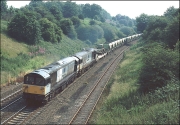 |
Moving to the 3 arch bridge at Hatton on the GWR route from Birmingham to Leamington, 58020+58012 are seen here climbing the bank on 9 July 1997 with the 6M31 Banbury to Mountsorrel self-discharge train. The time was 10.25 - the booked departure time from Banbury
was 11.15! The use of 58s was unusual as a single 60 was the booked traction at the time so a pair of of bones, both under power, was doubly noteworthy. To see how this this scene has changed in 8 years, use this link for a photograph of 66542 on
the 4E44 Southampton to Leeds freightliner in the same spot on 12 May 2005. 66542 on 4E44.
|
 |
Ironbridge Power Station lying in the Severn Valley on the former Buildwas branch is a major consumer of coal. To facilitate easy movement of coal to the station from collieries such as Littleton and Silverdale on the WCML, the Oxley
Chord was constructed. This obviated the need for a time-consuming reversal at Bushbury Junction. On my only visit to the location in January 1991, 58012 is seen with a load of coal squealing around the tight radius curve to join the Wolverhampton
to Shrewsbury line at Oxley. The main electrified line to Wolverhampton can be seen in the background.
|
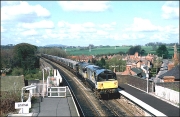 |
This train is returning from Ironbridge Power Station with its train of empty HAAs double-headed by 58003+58012 at 10.35 on the morning of 20 April 1991. It is pictured crossing Shifnal viaduct high above the town the name of which is not in doubt thanks to the carefully rotated station nameboard.
|
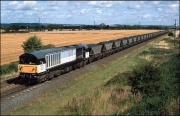 |
In 1994 it was rare to see anything other than a 58 on MGR traffic to Rugeley Power Station. 58009 is the subject of this study at Catholme as it awaits the right of way to turn right at Wichnor junction and head along the freight-only line to Lichfield Trent
Valley Junction. The driver has just returned to his cab after telephoning the signalling centre as he was held there for some considerable time. The background to this shot, taken on 29 August 1994 jhas dramatically changed with the construction of Virgin's Central
Rivers depot where the company's Voyagers are serviced.
|
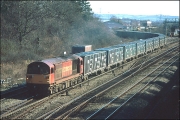 |
This picture shows the Calvert to Bath binliner shows 58049 leaving the Didcot curve at Foxhall Junction on 6 March 1997.
|



